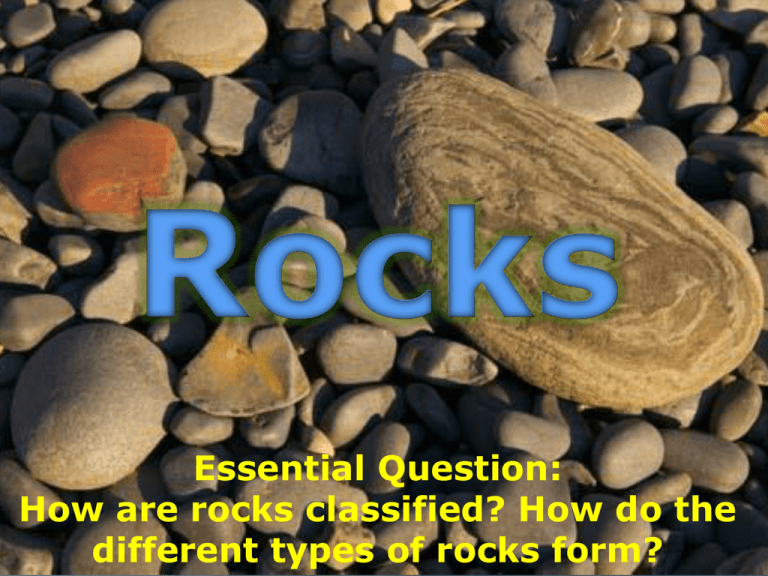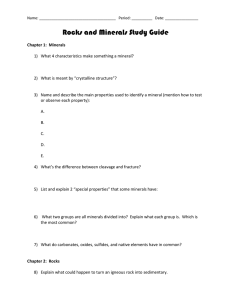Rocks PowerPoint
advertisement

Essential Question: How are rocks classified? How do the different types of rocks form? Rocks are made of mixtures of minerals and other materials. Some rocks contain one mineral, some contain several different minerals About 20 minerals make up most of the Earth’s crust; these minerals are known as rockforming minerals Geologists identify rocks by looking at their color, texture, and mineral composition to classify a rock Color- a rock’s color can tell how the rock was formed, but color alone doesn’t provide enough information to identify the rock Mineral Composition- geologists study the shape and color of crystals in a rock to help identify minerals that are in the rock; we can use the same tests on rocks that we use on minerals (example: chemical reaction test) Texture- geologists use texture, how the rock looks and feels, to help identify the rock; some rocks are smooth and glassy others are rough Grain Pattern: Banded vs. Non-Banded Grain Size: Fine Grain vs. Large Grains Grain Shape: Rounded Grain vs. Jagged Grains Geologists classify (organize) rocks into 3 groups based on how they were formed: IGNEOUS SEDIMENTARY METAMORPHIC “Ignis” = Latin for “fire” Formed from the cooling of either magma or lava The most abundant type of rock 2 Types of Igneous Rocks: Intrusive or Extrusive Below ground = from magma (intrusive igneous rock) Usually have LARGE crystal grains (they cooled slowly) Above ground = from lava (extrusive igneous rock) Usually have SMALL or NO crystals (they cooled too quickly) Formed from sediments (rock fragments, mineral grains, animal & plant remains) that are pressed or cemented together Sedimentary Rocks are formed through a series of processes: weathering, erosion, deposition, compaction, cementation. (WEDCC) Weathering Erosion The “dropping” off of sediment Compaction Running water, wing, loose ice carry away fragments of rock Deposition The breaking down of rock by wind and water Process where sediments are pressed together Cementation Process which minerals crystalize and “glue” sediments together The Grand Canyon is a great example of a large sedimentary rock! Sedimentary rocks may also contain fossils! As sedimentary rocks are deposited, they form horizontal layers Scientists know that the layers on top (and the fossils in the top layer) are YOUNGER than the fossils in lower layers. Rocks that have changed due to intense temperature and pressure “Meta” means “change” and morphosis means “form” in Greek Igneous, sedimentary and other metamorphic rocks can change to become metamorphic rocks Pressure from overlying rock layers High heat, but not enough to melt the rock Rocks may be flattened or bent or atoms may be exchanged to form new minerals. Foliated—mineral grains are flattened and line up in parallel bands Example: gneiss formed from rearrangement of minerals in granite into bands Non-Foliated—No bands are formed Example: marble formed from limestone Where magma intrudes relatively cool rock Near colliding plates (near mountain ranges) Places that are covered miles thick with other rock causing pressure When hot water intrudes rock Where a meteorite strikes Earth (rare) Where lightning bolts strike rocks (rare) The Rock Cycle is a series of processes on Earth’s surface and in the crust and mantle that slowly change rocks from one kind to another NO! Rocks are continually changed by many processes, such as weathering, erosion, compaction, cementation, melting, and cooling Rocks can change to and from the three types The core, mantle, & crust are one giant rock recycling machine




